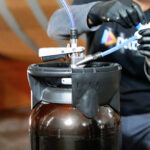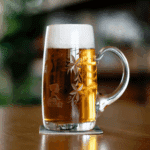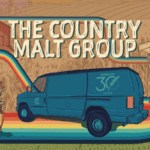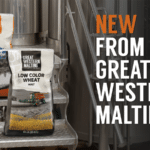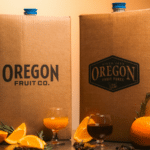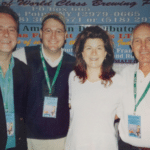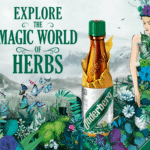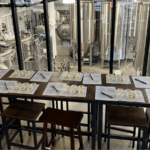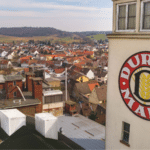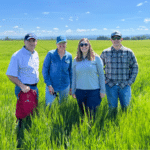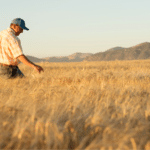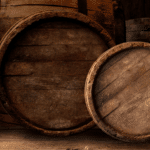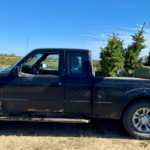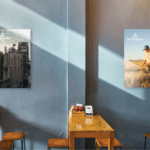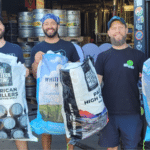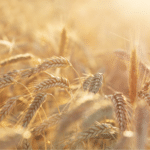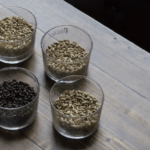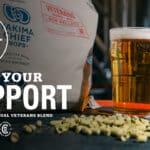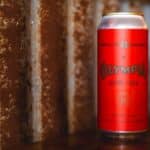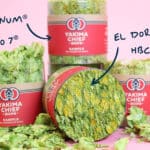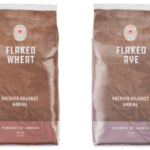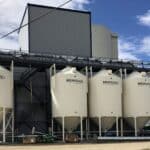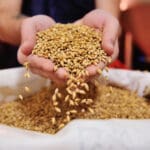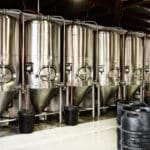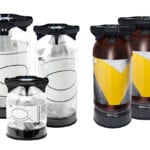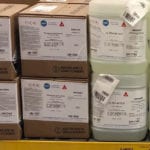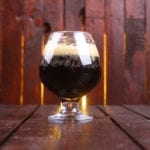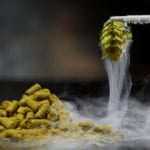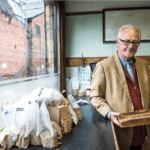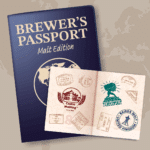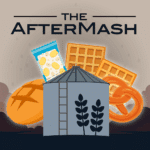OVERVIEW
Key grain growing regions in North America experienced record-breaking, sustained heat in early summer 2021, resulting in damaged grain crops, causing elevated proteins, lower than expected yields, and fewer plump kernels. Considering these changes, it’s important for brewers to understand the tools and strategies available to them to produce the best beer possible with 2021 crop malt.
As we have transitioned to the new crop, we want to ensure you’re aware of the incoming changes to your malt specifications. This year’s crop will have higher protein levels and an increase in kernel variability than we’ve seen in recent years. The good news is that you can still make quality beer from this malt. It’s key for brewers to keep an eye on Malt Certificates of Analysis (COAs) for the 2021 crop. Some maltsters in North America will be using a percentage of European and other imported barley in their malt and this will change the overall makeup of the COA.
MALT COA CHANGES
ELEVATED PROTEIN LEVELS
This year, we anticipate seeing increases of 1.0 – 3.0 % in the total protein in your malt. With this increase in overall protein, brewers may find that they need a little more malt to produce the same volume of beer. (With an increased protein, there’s slightly less overall starch to convert to sugar during the mash.) While the relationship between protein content and available extract is not linear, brewers can expect to see a decrease of 0.5 – 2.0% of extract in this year’s malt.
The easiest way to address this is to use more malt, however if your equipment limits the use of additional malt, other alternatives exist such as malt extracts or sugars. There are some fermentability and flavor concerns with pre-made extract and/or sugars such as dextrose, sucrose, and lactose when used in high percentages, but all are potentially useful tools for consideration.
Additionally, with an increase in total protein, there will also be an increase in soluble protein which can drive wort color creation. It’s important to note that it is the soluble fraction of the protein which the heat of the mash-mixer or kettle catalyzes to form melanoidins – the key color contributor to beer. Malt color may also increase this year due to the higher soluble protein content of malt going to the kiln. As maltsters dry the malt down to the desirable moisture content for storage and transport, the additional protein that is present in this year’s crop may drive the Maillard reaction further. Finally, increased protein can also drive a rise in FAN (Free Amino Nitrogen), potentially increasing ester and fusel alcohol production in fermentation.
KERNEL SIZE VARIABILITY
We also expect to see an increase in overall kernel size variability. Heat stress on the crop reduced the percentage of very plump kernels. Maltsters clean out the thin kernels so brewers don’t need to deal with them, but an increased variability of kernel sizing can be expected this year. It’s important that brewers evaluate their crush on a regular basis, especially as new crop is introduced. There is a helpful method for grist analysis posted online by the Master Brewers Association of the Americas (MBAA). Van Havig’s Craft Brewers Conference presentation “Improving Brewhouse Efficiency for Small Brewers” is another reliable resource for some brewers on our team.
OTHER BREWHOUSE STRATEGIES
If you’re not already doing so, start by checking the crush coming out of your mill by sieve testing. There are many videos and articles on this subject you can find in an online search. Knowing your water to grist ratio, true kettle and knockout volumes can help improve your beer and find extract you may have been sending to drain. An easy method for brewers to reduce the overall protein in their brew is to use “Nitrogen Dilution.” This is the technical term describing using sugar as a small percentage of the fermentables in order to dilute the overall protein in the wort.
For example, using sugar for 10% of the fermentable extract in a brew would dilute the overall protein by 10%, effectively reducing a 12% protein malt to 10.8% with the use of the sugar. While not widely employed in North America, this approach is commonly used in the UK to reduce wort protein.
With a higher protein, you may see increased mash viscosity, leading to slower lauters. With the success of many craft brewers, lauter-plate loading is often on the high-side as brewers look to maximize their production volumes. The classic recommendation of a maximum 200kg of grist per cubic meter of lauter plate surface area is a great rule of thumb this year. In order to avoid slow run-offs and reduced extracts due to mash-bed channeling, brewers may want to ensure that they are not overloading their lauter plates.
MASH-OUT REST
Another useful strategy this year is to employ a mash-out rest, by heating the mash to ~78°C as the final mash rest. The higher temperature reduces viscosity, allowing for easier lautering, less channeling and side-run, and better mash filtration to prevent fines and large proteins from transferring to the kettle.
PROTEIN REST
When faced with increased protein, many brewers choose to use a protein rest to break down potentially problematic long-chain protein to improve lautering and increase extract and fermentability. This can be a double-edged sword: It can reduce the level of high-molecular weight proteins in the mash, and reduce mash viscosity, however protein rests also significantly increase Free Amino Nitrogen (FAN), increasing ester and fusel alcohol formation. An excess of FAN / amino acids can affect diacetyl levels and reabsorption as well as potentially increase fusel oil and ester production, increasing these sensory components above the threshold of sensory detection, possibly contributing to a “dirty” fermentation aroma.
HIGH FAN
Higher FAN also contributes to yeast growth, and an elevated FAN can undesirably increase fermentation rates and increase yeast growth, resulting in excess yeast production and higher beer losses. Most craft beer is all malt and already loaded with FAN, but wort composition and fermentation changes may be a concern. The use of adjuncts, and adjustments in temperature, pitch, and aeration are all tools to help manage this issue.
Finings and Process Aids are important tools that many brewers use to optimize brewing and cellaring. These products are generally one of three groups: Hot-Side finings, Cold-Side finings, and Enzyme treatments. There are a variety of different highly effective products for brewers to choose from, and for this year, Country Malt Group recommends a combination of multiple approaches to ensure clear beer (except for hazys!) and good shelf-life.
Hot-side, or Kettle finings, include carrageen-based products such as Irish Moss, Kick Carrageenan, Polyvinylpolypyrrolidone (PVPP), etc. Cold-side, or cellar finings include Collagen, Silica Gels such as Nalco 1072 and others.
USING ENZYMES
Some enzymes such as beta-glucanase are designed to be used in the mash, while other enzymes are designed to be used in maturation, such as Brewer’s Clarex from DSM. With a potential increase in enzyme content of the malt, brewers may need to increase conversion rest temperatures to favor alpha, rather than beta amylase in order to prevent over fermentation. Brewers who use a step mash may want to evaluate mashing-in at scarification temperature rather than mashing-in low, and ramping to conversion temperature: If the ramp rate is slow, it is possible that most starch conversion will be completed in the beta amylase range, prior to even reaching the main saccharification rest. In lieu of stepped rests, we have other enzyme solutions sourced that are available by request.
IMPORTANCE OF MASH PH
Getting mash pH right during mashing is important: a pH between 5.2 and 5.5 will help to ensure proper enzyme function to optimize conversion. The correct pH also improves hop extraction during the boil bitterness and helps drive finished beer pH to the right range to precipitate protein and polyphenol during cold break and after fermentation. With more protein, you’ll also get more trub, so you’ll want to reoptimize your protein coagulant dosing in the kettle to avoid sending unwanted protein to fermentation.
CELLAR STRATEGIES
Excess long-chain protein can blind filters, cause clarity issues, and cause it to precipitate in packaged beer. Traditionally, brewers have stabilized beers with silica gel and/or PVPP, but today we can use a relatively new enzyme, Brewers Clarex. This was originally formulated as a chill-proofing agent, which works by preventing polyphenol-protein bonds, but it’s also now the agent which allows brewers to brew “gluten reduced” beers, while still incorporating barley and wheat.
Proper cold conditioning is key to forming and dropping out protein-polyphenol haze. This may be the time for brewers to check the state of their glycol and cooling systems to ensure that they can cold condition at below 35.6°F (or 2°C) to promote the formation and precipitation of haze. A few extra days close to freezing can make a big difference to haze stability of the finished beer.
Getting the pH of your beer in the “sweet-spot” for haze formation in aging is important and, combined with proper cold conditioning can assist in creating haze, and precipitating it out of the aging beer. A pH of about 4.2 is effective in forming haze: Hordein (barley protein) is least soluble just above a pH of 4. If brewers find that their pH is a little high after fermentation, small adjustments in the whirlpool can be made with phosphoric acid on subsequent brews.
From a brewhouse cleaning perspective, there may be more buildup of material beneath the lauter screens this year. Brewers should pay extra attention to cleaning under the lauter screens to ensure unimpeded flow during lautering. Some brewers have found that adding valves to each lauter outlet can improve CIP effectiveness beneath the screen.
NOTES ON FERMENTATION
As with any crop year change, brewers can expect changes to the enzyme profile and fermentability of their malt/wort this year. Once again, it is recommended that brewers keep a close eye on their Malt COAs to understand the changes. Depending how much protein you collected in the brewhouse, you may be sending an excess to the fermenter, and this could take the form of amino acids and/or FAN.
NEXT STEPS
This rundown is intended to help you plan how you’d like to handle the transition to upcoming crop. This year’s malt will require more attention, which is why we’ve provided ways for you to proactively address the current situation to ensure the best quality product for your customers. Give your Country Malt Group (CMG) Representative a call to discuss your specific situation, and how these products can assist you this year.
FREQUENTLY ASKED QUESTIONS
Transcript - Dark Side of the Malt
EPISODE S.2, E.24
[DARK SIDE OF THE MALT]
[00:00:00] TT: Welcome to The BrewDeck Podcast. I'm your host Toby Tucker. It's been a long time coming. We're extremely excited to finally carry the BESTMALZ roasted malts, which we've mentioned on a prior podcast. Just in time for the wintery months and the much-awaited welcome of the dark beer season.
Hey, Axel, thanks for joining us all the way from Germany. It's always a real pleasure having you and catching up. Let's just dive right in. What can you tell us about the new roasted malts?
[00:00:26] AG: Hello everyone. My name is Axel Gohler. I am the CEO of BESTMALZ, and I will be happy to give you some information on our roasted malts, why we think that they are very special, and why you can use them in your brewing in an almost ideal way.
First of all, I'd like to give you some information on the process regarding the malting of our roasted malts. Then I would like to give you some information about the roasting itself, which is also unique. Finally, I would give you some analytical details about the technical view on these products. Because we do believe that in the end, you will have a product that's coming out of our roasting that is not only better in taste, but also, scientifically, one can prove that this is a very, very exceptional product.
Coming back to my first part of this small story about our roasted malts, regarding the malting, most people don't know that we have fully malted grains in our roasting. Well, we don't roast chit malt or non-malted grains. In reality, we are really having a two-phase process. The first phase being the malting itself, and then we have the roasting. We are strong believers that when you have a roasted malt, and you want to offer roasted malts to the brewer, you really need to take as much care and diligence for the malting as for the roasting.
In our malting and for the roasted products, we only use Berlin program recommended raw materials. This is very important because theoretically, one could use other six-row barley, foreign grains that are available. But we don't do that. We follow the same principles that we have in our general malting; we also follow for our roasting. We make no differentiation of the malts. This is my dog in the background. She also likes roasted malts, but she doesn't like me talking to my mobile.
We only use the Berlin program recommended raw materials in our roasting. During the malting phase in steeping and germination, we follow a manually controlled, fully tuned process. That means we have a high degree of checks and interventions in order to make sure that we really come out with the best possible malt, which is then the pre-product for our roasting.
We have a well-developed specific kilning routine in order to achieve optimal conditions for any crop and grain condition. Of course, we're working with natural products, and we need a flexible approach to cope with seasonal changes in our natural ingredients. In the malting, we have quite a strong element of manual controls and manual intervention.
Finally, before we use the pre-product or before we can use the pre-product for our roasting, we need clearance by our QS team so every batch that we are using in our malting is being tested whether we have the ideal conditions for the pre-product that is then used in the roasting. Coming to the roasting phase, first of all, we are having extremely small batches of roasting batches, which is 100 kilograms per batch only. The reason is that, of course, we want to make sure that we can reach precisely the color values that we are giving in our specification sheets.
Since the roasting and the adaptation of color depends a lot on the season, depends a lot on the water content of the malts; therefore it's very important for us to monitor very closely the condition of the malts before we roast it in order to be able to adjust and reach precisely what we are promising to our customers.
We have individual recipes for our different roasted malts. Here we're using the experience from our malt masters in our production who have developed these individual recipes.
Batches are tightly controlled. We have two people who are working in the roasting all the time. There's always a backup in our roasting team. All the specs must be fully confirmed before we can give it to the logistics team.
Of course, we get data from the production. We have a highly automated data control system, which gives us all the details on the temperature in the roaster on the condition of the malt in the roasting process, so we can monitor these both visually and technically from the data that we get out of the process.
After productions are finalized, the roasting team takes samples of completed custom order for final tests in our best labs. The individual batches and the final product are validated and stored in our retained sample depository. This is very important because we keep all malts—no difference again between the roasted malts and all our other malts—for at least 24 months in our depository to have complete transparency on what our customers get.
This describes pretty well why we believe that we have a pretty unique process here. Of course, it is quite labor-intensive. This is not an industrial product by any means. It's manually controlled and thoroughly checked products that we are offering to our customers in our roasters.
Coming to my last part of this little podcast, if you will, this is the analytical evaluation of our roasted products. The reason why we have a very smooth and round taste in our roasts, and you don't feel this bitterness, this stringent bitterness that very often you get when you try or even eat roasted malts. You feel this bitter taste, which is unwanted, of course.
The reason why we don't have this is that the so-called [...], which are causing this bitterness, in our roasted malts are 30% below compared to the roasted products manufactured in the traditional steel drum. There are different types of [...], and we thoroughly check all the time how our roasted products perform versus traditionally drum roasted products.
We find that in some [...] groups, we have differences of -63%, and the categories where we have the least reduction is -3%. But on average, we have around 30% less [...] in our roasted malts. This has to do with our unique process because we are using a so-called fluid bed roaster. No husks get burned on the steel drum because, in our fluid-bed roaster, the roasting kernels are blown up in the air and then roasted while they are dancing around the heating device. That is really the reason why we don't have these [...] so much in our roasting process.
Of course, as a brewer, you're also interested in the [...], in the oxygen radical absorbance capacity, and other factors which are important for you as a brewer. I can tell you that the [...] or the oxygen radical absorbance capacity is similar to other roasting products, so we have no big difference here.
But the [...] are the most outstanding category of parameters, which are different in our roasting rather than the traditional steel drum roasting for the reasons that I have already mentioned. The fluid-bed roasting strongly reduces [...] causing stringent bitterness, and other parameters are more or less equal with traditional roasted malted products.
Let me summarize the advantages of our roasting products. We are roasting, number one, a fully malted pre-product. It's a two-step production approach. We don't use green malt or any other products that have not been fully malted. Second, we are only using the Berlin program barley. No inferior barley, no six-row barley, nothing of that kind. Only German barley is being used in our roasting.
Three, roasting in tiny batches of around 100 kilos per batch, not more. Four, fluid-bed roasting causing less burnt kernels and avoiding this bitterness. We have number five, a very smooth taste with less [...]. Six, we are extremely adaptive to different crops with flexible small batch roasting.
Seven, we have no need for de-husking and possibility to use husks in the brewing process. Because in filtering, of course, the husk plays a major role. If you can, you would like to retain the husks. Since we're not burning the husky, to begin with, you as a brewer can use them in your brewing process and take full advantage of them.
We have all color tones available, from very pale to almost black. Please have a look at our portfolio of products. We go up to 1400 EBCs and start with very, very low roasted products. We can use our roasting also for other grains±rye, maize, spelt, wheat, malt, or raw wheat. We have many applications, and we can almost roast whatever you want.
We are 100% compliant with German Purity Law in our roasting, like with all our other products. We can also offer organic qualities. Again, have a look at our portfolio on the internet, on our website, and you will see that we can also offer organic qualities in our roasted portfolio.
We also have some malts especially suited for distillers. For instance, our BEST Biscuit, which we think is another extraordinary product. If you haven't tried it, you should. We got very positive feedback from distillers who really like this product because they think it has a nice roasted taste, and it's great to work with in distilling.
This pretty much sums up what we think is special about all roasting. If you haven't tried it, you should. If you have any further questions, feel free to contact me; shoot me an email at ag@bestmalz.de, and I'll be happy to answer together with my technical team. I look forward to getting your feedback. This was Axel Gohler, CEO of BESTMALZ and malt it up.
[00:11:50] TT: Thanks a bunch, Axel. We're so excited to be carrying the BESTMALZ roasted malts: the Chocolate, Black, and Black eXtra here in North America.
[00:11:58] GL: Our next couple of guests are two brewers that make fantastic beers. We wanted to get some that were spread out in different parts of the country. I got my buddy from Oddwood Ales in Austin, Corey Hebert on. I don't know him as well, but he was introduced to us by our counterpart, CJ Pinzone, and really spoke highly of his beers. I can't wait to talk to Josh [...] from Separatist Beer in Pennsylvania. What part of Pennsylvania, Josh?
[00:12:25] JF: We're in the Lehigh Valley, about an hour north of Philadelphia.
[00:12:28] GL: Awesome. All right. We'll just launch into it. Let's start with you, Josh. I guess who are you, and where's your brewery located? I know you just mentioned it, but for those out there listening that don't know where that part is in the PA, can you tell us a bit more about it?
[00:12:41] JF: Sure. My name's Josh [...], as you mentioned. I'm the head brewer at Separatist Beer Project. We're based in Easton, Pennsylvania, which is, I guess, considered northeast Pennsylvania along the Jersey border. About an hour north of Philadelphia. It's, I think, Allentown, which is one of the Lehigh Valley cities. It's the third-largest in Pennsylvania.
It's a pretty big location, a good amount of people pretty spread out. We have a great opportunity to reduce the amount of folks. Then, obviously, Separatist also has a taproom location down in Philadelphia in the [...] neighborhood. It's really great that we can get down there too.
[00:13:21] GL: When did you first open your location?
[00:13:24] JF: Separatist has been around, some iteration or not, for about six years. I've been with the company for two years. They opened originally with the Easton location and then quickly built out what we call the Blendery. That's a 4000 square foot facility that is where all our mixed culture is done. I've got six 30 barrel footers and about 120 mixed 60-gallon barrels that we basically treat the whole place like a big solera project. We get to pull a little bit from here and there and re-dose. We got some fruiting tanks and things like that. It's a fun little project that we do.
The main portion of our brewing is done out of Easton. The [...] taproom was opened about three years ago now.
[00:14:11] GL: Corey, can you tell us a little bit about yourself?
[00:14:14] CH: Yup. Corey Hebert. Head brewer at Oddwood Ales, Oddwood Brewing, now in Austin, Texas. We're a smaller neighborhood group of breweries. Do a lot of lager beer, hoppy beer, mixed culture beers. Been a head brewer there for about three years now. I was head brewer at Adelbert's here in Austin for a couple of years before that, Ranger Creek Brewing down in San Antonio, assistant brewer down there for a couple of years. We're in Austin, a great beer scene. I'm sure most people have heard of it before.
[00:14:40] TT: There are a lot of people moving there, I know that.
[00:14:44] GL: Yeah, that's true.
[00:14:45] TT: Hey Corey, I know of you, number one, because of the great beer that Grant tells me about all the time, but specifically because I was talking to Axel over at BESTMALZ a few days ago. He mentioned you guys, and I want to learn more. You guys are used to brewing beers with BESTMALZ specifically, but you guys won some sort of picture calendar competition recently?
[00:15:05] CH: Yes. Grant got us to throw a picture on the hat, I guess you would say, for the calendar contest. We got our assistant brewer out on the little park creek thing picking up trash. Had him BESTMALZ [...]. He did a little picture collage, and apparently, they liked it.
[00:15:28] TT: That's pretty cool.
[00:15:29] CH: Yeah, it was cool. We got €500, so that's cool.
[00:15:35] TT: You should have asked to get a free trip after to go see Axel and his team over in Germany.
[00:15:39] CH: That's what I really wanted. I was hoping we would get something like that.
[00:15:43] TT: He used to, and I don't know if he still offers it, Grant, with the…
[00:15:47] GL: That's the Best Brew Challenge.
[00:15:48] TT: Yeah, the Best Brew Challenge, which if you guys haven't done it, he does it every year.
[00:15:51] CH: Was that the one you were just telling me about, Grant?
[00:15:54] GL: Yeah. The spring one.
[00:15:55] CH: In march? Okay.
[00:15:56] GL: Yeah. Basically brewing a beer with BESTMALZ as the base malt. They tell you which one each year, and then if you win that one, you get to go out and see them.
[00:16:05] CH: They pay for the whole trip and everything?
[00:16:07] GL: I'm not sure.
[00:16:08] TT: They used to.
[00:16:11] GL: Toby would know better than I would on that one.
[00:16:13] TT: Going back to Josh, have you brewed historically with BESTMALZ products, or was this kind of the first go at it when we started sampling some of this new roasted product out to market?
[00:16:22] JF: We've used it in the past here and there. I can't say that I've used it specifically as a base malt. I also work for another brewery in Bethlehem called Bomb Place. I was looking back at old invoices of brew recipes today, and we've got you some BESTMALZ sour, some of the wheat, some of the Biscuit malt. We made a red ale using their red malt.
[00:16:47] TT: Red X malt.
[00:16:48] JF: Yeah. I believe at one point they had that hell malt. We were trying to get some of that, but I can remember if we actually brewed with them. I couldn't find it in the brew logs.
[00:16:57] GL: [...].
[00:16:58] JF: Yeah. That's exactly what it was. But for Separatist, this was the first time they used their roasted malt for us.
[00:17:06] TT: That's cool. Did you have experience using some other types of roasted malts from other vendors?
[00:17:12] JF: Yeah. I think primarily in the past, I've used Blackprinz a lot. That's been a go-to debittered malt. When I was approached by CJ to see if I would be interested in using the BESTMALZ, I really wanted to make sure that I could find something comparable to that debittered black malt that I've come so accustomed to because the idea behind the specific beer was to do an American style stout with coffee. I wanted something that would highlight a depth of flavor without becoming too accurate or stringent but also achieve that color that we're looking for.
[00:17:45] TT: Yeah. Just to kind of back up that, we've mentioned with Axel as well. They've got three roasted products new to the market. It's the Chocolate, the Black, and the Black eXtra. Josh, did you use a little bit of all three? Which of those three did you use in that beer?
[00:17:59] JF: We used Chocolate and the black extra. The [...] had 5% of the Chocolate, and then about just shy of 2% of the black extra. Got some really great color and flavor from it.
[00:18:12] TT: What did you think about the final product? I know the roasting method CJ chatted with you about, and I know Axel did earlier on the show, but it's pretty unique. You tend not to get that acrid flavor that you mentioned as the fluid roasting process is so unique that the kernels just don't make contact with any steel to create that burning on the husk. What did you think?
[00:18:33] JF: Yeah. I'd agree. I guess, even going back further, prior to getting into the [...] I was in now, I worked for a malt house in southern Pennsylvania, so I had the opportunity to learn a little bit more about the malting process. I was a maltster there for about four years and ran their brewing programs well.
Understanding a little bit more about the roasting process and talking with CJ, reading up on how BESTMALZ uses their roaster in such a way that it really develops a great color profile without any of that burnt quality or some of that charred quality that you would get with some of the other roasted malts.
[00:19:13] TT: Yeah. I think the other thing to mention too, and Grant, prior to being introduced to this, started working on this project three years ago. I know you, and I were starting to sample some of the stuff that they were making in that [...] roaster, like I said, three years ago. I know it's a very unique product. I think the interesting thing is I don't know how many other maltsters, if any, are doing it. But they go into the roasting process with a pre-malt. It's an already malted product. Not just a green malt or such.
[00:19:43] JF: Yeah, I think with that particularly, you run the risk of you've already got a really friable husk on the malted product, and so it'll burn very easily. If you can use a green malt, the chances of charring or developing some of those astringent flavors are much less. Obviously, if you go slow and if you're able to ramp up the roasting temperatures in such a way, you can develop some really pleasant flavors and depth of color.
[00:20:09] GL: When you were malting Josh, you're saying most of the time you're just using a standard drum roaster.
[00:20:15] JF: Yeah, exactly. We're a small malt house. We did about two tons per batch, so very small. Everything was floor-malted. The roasting capabilities that we had were pretty minimal. We could do some melanoidin and some crystal-style malts, but to get some really deep black malts, that Chocolate, or coffee you really run the risk of…
[00:20:38] GL: Explosion?
[00:20:38] JF: Yeah. Explosion, fire. You can easily catch a batch of malt on fire in a roaster if you're not careful. We tend to step back from those types of things. I think since then, they've gotten some new equipment. They're able to do some of those like now. But when I was there, it was very limited.
[00:20:57] GL: Yeah. That's just a common thing in the malt world. Accidents happen, but whenever they're roasting 22 metric tons of malt or whatever, it's a giant bomb you've built. It's a little scary but cool.
[00:21:13] TT: I'm just thinking about, in general, even with stouts and dark roasted beers, the inclusion rate of roasted malts is so low. It really contributes when you get in that dark stuff the entirety of the flavor. A lot of the other stuff gets lost because of the roasted products. Josh, to answer your question and going back about the beer that you made, you mentioned some of the qualities about it, but can you expand upon that? Particularly what the Chocolate and other roasts did in that beer.
[00:21:44] JF: Yeah. I guess to preface that my goal with this beer was to develop an American stout and one that was true to color. I wanted something 30 or higher to really get some nice color to it. But you always run the risk when you're trying to develop a color that deep that you can overpower the beer with unwanted roasty flavors or astringency.
The idea was to layer a nice base malt. We used some toasted oats. We used some toasted flaked barley, some of the Chocolate, some crystal, and the Black eXtra. Keeping that all in mind, I wanted to develop a good to base stout that would complement the addition of coffee.
Really trying to find the fine line of can the stout stand up on its own, but not be so overpowering that the addition of coffee would either overpower the stout or that the stout would muddle the coffee.
I found that just layering those, specially malts, specifically the Chocolate, the Black eXtra, some of the toasted adjuncts, you're able to just build layers of flavor that lend itself very well to the addition of coffee so that you get everything. You don't just get coffee; you don't just get stout, you just get this really nice palate of Chocolate, roasty coffee. The fruitiness of the coffee still comes through. It's just a really pleasant beer. Everything that I wanted it to be worked out really nicely because of the malts.
[00:23:10] GL: Awesome. What did you end up calling that one?
[00:23:12] JF: This one is called nervous whispers. We did it in conjunction with a great local roaster down here or up here called Homestead Coffee Roasters.
[00:23:25] GL: Cool. Is that out on draft right now?
[00:23:27] JF: It's out on draft and tin cans. We got it in the taproom.
[00:23:31] GL: Well, it was good having both you guys on. I know Corey's really known for his lagers. We're talking stouts, but I want to talk a little bit about Corey Schwarzbier. Can you tell us a little bit of that, Corey?
[00:23:42] CH: Yeah. We're big BESTMALZ boys over at Oddwood. Heidelberg is pretty much our base malt on a lot of things, [...]. I mean, like Frank's RedHot, we put that [...] in everything. You have to believe me on that one, I guess.
[00:23:57] GL: No, it's all good.
[00:23:58] TT: It is the truth, sir. It's the truth. Tappetino or jalapenos.
[00:24:04] CH: We did two beers with it. We did the Schwarz, which is 50/50, BESTMALZ pils and [...], and then one bag of the Chocolate. Typically, I used Carafa, Weyermann, [...]. It's the one I've always used, one, two, three depending on color and other certain flavors, whatever you're looking to get out of that.
But for the past couple of years, I've been using it. I just wasn't really into the flavors. We kept getting like this just parmesan on this thing that I can only attribute to that because other than that, it's like some [...] tradition and poster malt, so there's not really a lot of places where it comes from. I can't really figure it out.
Then this year, we're doing it with Chocolate. It just was night and day. It really blew my mind how much better it was. I knew Best was good, but then after tasting it, it's just, like I said, night and day. It's super smooth, light roast. It's just all-around a great beer. Big adamant believers, and at least six-day a week lager time. This thing will be at 12 weeks when we go to can it on Monday. It's just so smooth, clean, and everything I wanted from it. I couldn't be happier, honestly with the Best.
The stout we did, essentially, we did stout, Toby, because you gave me a bag of Chocolate. Then I got a bag of Black eXtra. We did a stout too. It's essentially a homage. We have a little coffee truck on-site called Terrible Love. They do this signature latte. It's called the Terrible Latte, and it's like a Chocolate banana latte. We did a stout in that van. The base was especially 60/40 Baird, Maris, Munich, and some of the [...] dark crystal, the MFB Kiln coffee, and then a bag of extra black from Best. We did some Belgian dark candy sugar lactose.
[00:25:59] GL: Really [...] that one up.
[00:26:01] CH: I told you we tried that Bananza from Omega for the first time, just because I didn't really know any other way to get banana flavor. We put the bananas there. We did the [...] too.
Also, we worked with—he doesn't actually roast, so he's just kind of a coffee truck, but he's good friends with another roaster right on the road called Tiny House. Tiny House did the cold brew concentrate for us. That one's interesting. It's definitely my first foray into the pastry stout category, for lack of a better term, but it turned out good. It's interesting. I'm definitely more on the Schwarzbier camp. It's a cool beer. I think the general populace will appreciate something like that.
[00:26:51] GL: Sure. You got both of those on tap right now at Oddwood?
[00:26:55] CH: They both go on Monday. They're all kegged up. The portion that's kegged and then will can it Monday; they'll both be on next week.
[00:27:02] GL: Hell yeah. Okay.
[00:27:04] TT: I see that Josh is actually drinking and enjoying the Nervous Whisper. Man, if the listeners can see. He's just enjoying it. I'm pretty thirsty now. I don't have a beer in front of me.
[00:27:21] JF: Sorry, guys.
[00:27:21] TT: No, it's alright. Enjoy the fruits of your labor. Josh, can you think of any other styles for the listeners that you think of this type or these types of malt—the Chocolate, the Black, and the Black eXtra—that some kind of beer styles that they might also work well in?
[00:27:37] JF: When I was reading over that question, I mean, Schwarzbier popped into my head immediately. The fact that Corey did one makes perfect sense. I really think with Chocolate, and a little bit of Black would go well as a compliment to a dark-mild. An English-style dark-mild or even the porter.
[00:27:54] GL: I like the mild idea, don't see much of those these days.
[00:27:58] JF: At [...], we traditionally do a lot of English-style beers. That's kind of what we're known for. We have two of our, I guess "flagships," an English bitter, and then a dark-mild. I could definitely see using the BESTMALZ in that. I think it would compliment it really well.
[00:28:16] GL: Do you cask condition those and go through the full nine yards?
[00:28:19] JF: We have a cask program that we do very traditionally, but we will not cask condition the entire batch, just for ease of life and not trying to [...] things. But if we could, we would definitely do everything cask-conditioned, but it's not feasible at the moment.
[00:28:39] GL: Speaking of tradition, I don't think Corey had mentioned it, but he's really big on the horizontal lagers. Can you tell us a bit about that, Corey? How many tanks do you have that are horizontal?
[00:28:48] CH: We only have two right now. We're in the process of getting two more, hopefully here pretty soon. We got a new brewhouse that's supposed to be here since September. We have a landing date in January. Once we can get that ironed out, then hopefully, we can have a couple more horizontals.
But yeah, we're big on the horizontal. Austin's a huge lager town. You got OG's like Chip at Live Oak. Texas, in general, it's pretty hot down here. Lager is just really conducive to our way of life. If you're going to make lager in Texas, especially Austin, you have to bring your A-game. Every beer usually spends about two to three weeks in the conical. And then, of course, [...] and then crash. We will move it over to the horizontals.
We're doing this new thing next year called the Oddwood Larger Dogs. We're going to drop a new lager four-back every month all the way through December. If you get all 12, then you get some real sweet prices at the end of the year and stuff. Essentially, they'll go to the horizontal, and then if it's a batch that we're going to can, then it'll just stay there for the full. If it's spent three in the primary, then we'll try and hit five in the horizontal. Then, let's say, they're going to the terpene tanks, [...] pubs, so we move a lot of beer, really 98% of the beer out of the taprooms.
They go to the serving tanks; sometimes we're going to play serving tanks shuffle. It might only spend four weeks on the lager tanks, and then it needs another one or two in the serving tank. But it's really just about hitting that eight-week mark. I don't know what it is. There's just something to it. It's magic; we try them early, and there's something to that, a killer beer or whatever. But there's something about that eight-week mark. When I'd go pick Swifty's brain on lagers when I was first starting out, he'd just say eight weeks. Just give it eight weeks. The rest will be [...] We trusted them and started doing it, and sure enough, the magic happened.
[00:30:53] GL: Funny how that works, just time, give it time. It's just like brisket, low and slow. Just give it time.
[00:30:59] CH: Exactly, time and temp. We're kind of known in town for our lagers. A lot of people ask me, what do you do? We don't filter anything. The beers will be diamond bright, and they're like, what do you do? Just time and temp. Just keep it cold and just let it sit there. The horizontal really helps a lot, too, honestly, for flocculation. I think that's really also the awesome part of them. Conical's great for ferment because you can harvest your yeast, then moving it over to horizontal, and just give it its time, and it will floc out the lager magic will happen.
[00:31:32] GL: Absolutely. Well, I'll pose the same question for you while I got you here. You've got a pastry stout and a Schwarzbier, any other gears turning, sprinkling some to like—well, I guess an Altbier is not really a lager. But any other kind of Adambier, maybe? Something else that you would be into.
[00:31:50] CH: Yeah, These malts would be great in anything going from mild into the dark realm. I tend to like less roasty characters a lot of the time from black malts and stuff like that. I mean, I was thinking that if you do a Dunkel, any kind of, like you said, porter or brown, really anything that you want. Some nice roasty flavor, but again, without the acridity or any of that harshness that might come with. Roasted barley has its place, of course, dry Irish, and stuff like that. But anything you're just wanting, like a nice smooth malt flavor, this is the perfect malt for you.
Then, of course, color-wise. Honestly, doing the Schwarz with the Chocolate, I think I was telling you, I might actually bump it up to the black.
[00:32:38] GL: To the middle one.
[00:32:39] CH: To the middle one next year. It's still got a nice color, but maybe I want just a hint more.
[00:32:45] GL: I'm with you. For those out there listening, I actually had the pleasure of coming out to brew that one with Corey. It's really fun. Always fun seeing a new brew house, and you did 9% chocolate in that Schwarz?
[00:32:57] CH: Yeah. It'd be around 9%. Not quite 10% because for us everything's, 10 barrels, five bags of pils, five bags of Vienna, and then one bag of Chocolate.
[00:33:07] GL: I haven't got to see the beer yet or try it, but I'd take it at 9% with the Chocolate. It still turned out opaque like a Schwarzbier should be.
[00:33:15] CH: Yeah. It's dark, and if you put our flashlights here, it's got that rich crimson mahogany. You can pretty much—
[00:33:24] GL: [...] around the edges.
[00:33:24] CH: Right. It's black, brown. It's right there.
[00:33:30] GL: Got you.
[00:33:30] TT: Well, I'd say, Josh, you're talking to three Texans here. Like Corey mentioned, it's hot down here. I think it's 80 degrees here in Dallas right now. It's probably the same down there south for you guys, right, Grant?
[00:33:41] GL: It's 85 today here.
[00:33:44] JF: It's 32 here right now.
[00:33:48] TT: You guys up there are used to it. If it's 32 here, it's a bunch of crazies trying to drive around. It's a complete panic. It's panic time. I'm telling you. Josh got the full beard. He just looks like a warm guy. He's prepared. But we're a bunch of pansies down here.
[00:34:05] JF: My parents live in Florida. I won't go down there between April and October. I only go down and visit them when it's like this time because it's the only time that's bearable for me.
[00:34:18] GL: For sure.
[00:34:19] TT: Josh, are you serving the nervous whisper, or are you guys doing a small batch, or is there a format? Listeners, if they're in that area and you guys are open, obviously, can somebody come try or what?
[00:34:30] JF: This was a 40 barrel batch that we did. We've got draft, tin cans. I don't handle much in the front of the house. When my day is done in the brewery, I just go home. I don't hang out in the taproom much, but from what I've heard, people have been really receptive to it. We had a vision in mind, and it seemed to work out really well. We're very happy with it.
[00:34:51] TT: All right. Josh, tell us about—obviously this beer, I see you're sipping on. It looks fantastic. Any other beers in the works, anything you're doing unique here in the future that people can expect to see on tap or part of the brew?
[00:35:04] JF: We actually just did a beer that's released that was using all HBC630, which is a really cool hop that we got through Country Malt. It's got this really cool strawberry, daiquiri, orange, creamsicle thing. We brewed a double IPA and added a little bit of Carapils to it just to give it a really nice orange hue, and a little bit of oats to give it some mouthfeel. Then just top the hell out of it with this HBC630.
[00:35:39] GL: Yeah. That's the cherry candy one.
[00:35:41] JF: Yeah. It's really heavy on the candy, heavy on the stone fruit, some great strawberry quality. We do a collaboration every year called All The Feels. It's a triple IPA that is a play on panettone cake, the Italian Christmas cake. It's got a sweet and bitter orange peel. It's got some golden raisins. It's got a little bit of spice to it. Ceremoniously, we throw about 10 of these panettone cakes in the [...] for Instagram, basically.
[00:36:19] GL: How is that lager?
[00:36:22] JF: It's awful. But it's fun. It's an 11% thing that we put out around Christmas, and people tend to like it. But I'm trying to really develop our lager program a bit more. There was not much of it prior to me coming on. I've been trying to develop that a little more. I have a big affinity for lagers and English-style beers. If I can work those in, I'll do that. We've got a couple of new lagers coming out. We did a Marzen beer around the start of the Oktoberfest time frame. We've got a Czech lager and an Italian pilsner coming out. I'm excited about those.
[00:36:59] TT: Fantastic. Well, I really appreciate you guys coming on and getting some info about the BESTMALZ products. They are available for the listeners. Grant, I checked earlier today, but pretty much in all over North America DC's are still waiting on a few transfers, but the product should be readily available for listeners, the brewers out there that want to give it a try. We got a couple of fantastic brewers today that enjoyed it. I wish I was there taking a sip off what they're drinking right now. They do look great.
[00:37:26] GL: For sure. If you're in the area, definitely stop by, try some Separatist Beer, try some, what was it, whisper? Say it one more time.
[00:37:33] TT: The nervous whisper.
[00:37:34] GL: the nervous whisper, for sure. If you're ever down in Austin, Texas, don't miss the lagers that Oddwood. Corey kills it.
[00:37:42] CH: We got some really good ones on right now.
[00:37:43] TT: I was just thinking about the times I get a nervous whisper, when I have to approach my wife about taking yet another hunting trip every year. Awesome. All right, guys, I really appreciate your time. I love that you guys got your hands on some of the BESTMALZ stuff. Corey, congrats on the winning of that poster. Is it like a fully clothed poster?
[00:38:13] CH: Yeah. He's got his clothes on. He was actually in his BESTMALZ hoodie that Grant gave us.
[00:38:19] TT: Nice. Well, we have to make sure we get a copy of that and post it on our social so we can give some shouts out to you.
[00:38:27] CH: Yeah. I sent it over to Grant. He should have all of it.
[00:38:30] GL: Yep. We got it. I think we're going to re-share it on Instagram here pretty soon.
[00:38:34] TT: Nice. All right, fellas, I appreciate your time again, and I look forward to catching up with you sometime in the future. When I make my way up to PA, Josh, I'll come knocking at your door, believe me.
[00:38:44] JF: Yeah. Absolutely. Thanks for having me on.
[00:38:46] TT: Corey, see you, buddy. Thank you.
[00:38:47] CH: Sounds good. Thank you.



